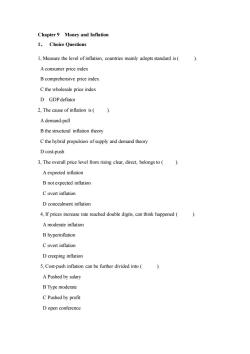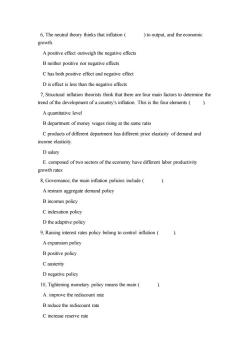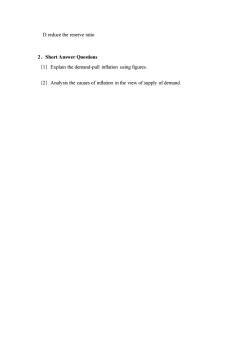同济大学:《货币金融学》课程教学资源(试卷习题)Chapter 9 Money and Inflation

Chapter 9 Money and Inflation 1、Choice Questions 1,Measure the level of inflation,countries mainly adopts standard is( A consumer price index B comprehensive price index C the wholesale price index D GDP deflator 2,The cause of inflation is( A demand-pull B the structural inflation theory C the hybrid propulsion of supply and demand theory D cost-push 3.The overall price level from rising clear,direct,belongs to () A expected inflation B not expected inflation C overt inflation D concealment inflation 4,If prices increase rate reached double digits,can think happened A moderate inflation B hyperinflation C overt inflation D creeping inflation 5,Cost-push inflation can be further divided into A Pushed by salary B Type moderate C Pushed by profit D open conference
Chapter 9 Money and Inflation 1、 Choice Questions 1, Measure the level of inflation, countries mainly adopts standard is ( ). A consumer price index B comprehensive price index C the wholesale price index D GDP deflator 2, The cause of inflation is ( ). A demand-pull B the structural inflation theory C the hybrid propulsion of supply and demand theory D cost-push 3, The overall price level from rising clear, direct, belongs to ( ). A expected inflation B not expected inflation C overt inflation D concealment inflation 4, If prices increase rate reached double digits, can think happened ( ). A moderate inflation B hyperinflation C overt inflation D creeping inflation 5, Cost-push inflation can be further divided into ( ). A Pushed by salary B Type moderate C Pushed by profit D open conference

6,The neutral theory thinks that inflation )to output,and the economic growth. A positive effect outweigh the negative effects B neither positive nor negative effects C has both positive effect and negative effect D is effect is less than the negative effects 7,Structural inflation theorists think that there are four main factors to determine the trend of the development of a country's inflation.This is the four elements () A quantitative level B department of money wages rising at the same ratio C products of different department has different price elasticity of demand and income elasticity. D salary E.composed of two sectors of the economy have different labor productivity growth rates 8,Governance,the main inflation policies include A restrain aggregate demand policy B incomes policy C indexation policy D the adaptive policy 9,Raising interest rates policy belong to control inflation A expansion policy B positive policy C austerity D negative policy 10,Tightening monetary policy means the main A.improve the rediscount rate B reduce the rediscount rate C increase reserve rate
6, The neutral theory thinks that inflation ( ) to output, and the economic growth. A positive effect outweigh the negative effects B neither positive nor negative effects C has both positive effect and negative effect D is effect is less than the negative effects 7, Structural inflation theorists think that there are four main factors to determine the trend of the development of a country's inflation. This is the four elements ( ). A quantitative level B department of money wages rising at the same ratio C products of different department has different price elasticity of demand and income elasticity. D salary E. composed of two sectors of the economy have different labor productivity growth rates 8, Governance, the main inflation policies include ( ). A restrain aggregate demand policy B incomes policy C indexation policy D the adaptive policy 9, Raising interest rates policy belong to control inflation ( ). A expansion policy B positive policy C austerity D negative policy 10, Tightening monetary policy means the main ( ). A. improve the rediscount rate B reduce the rediscount rate C increase reserve rate

D reduce the reserve ratio 2.Short Answer Questions (1)Explain the demand-pull inflation using figures. (2)Analysis the causes of inflation in the view of supply of demand
D reduce the reserve ratio 2、Short Answer Questions (1)Explain the demand-pull inflation using figures. (2)Analysis the causes of inflation in the view of supply of demand
按次数下载不扣除下载券;
注册用户24小时内重复下载只扣除一次;
顺序:VIP每日次数-->可用次数-->下载券;
- 同济大学:《货币金融学》课程教学资源(试卷习题)Chapter 8 Money Supply and Money Demand.docx
- 同济大学:《货币金融学》课程教学资源(试卷习题)Chapter 7 Financial Markets.docx
- 同济大学:《货币金融学》课程教学资源(试卷习题)Chapter 6 Central Banks.docx
- 同济大学:《货币金融学》课程教学资源(试卷习题)Chapter 5 Commercial Banks.docx
- 同济大学:《货币金融学》课程教学资源(试卷习题)Chapter 4 The Economics of Financial Intermediary.docx
- 同济大学:《货币金融学》课程教学资源(试卷习题)Chapter 3 Interest and Interest Rate.docx
- 同济大学:《货币金融学》课程教学资源(试卷习题)Chapter 2 Credit and Financial Instruments.docx
- 同济大学:《货币金融学》课程教学资源(试卷习题)Chapter 1 Money and Monetary System.docx
- 同济大学:《货币金融学》课程教学资源(大纲教案)教学大纲 The Economics of Money and Banking.pdf
- 吉林大学:《财政学》课程教学资源(试卷习题)远程教育考试样卷(无答案).doc
- 吉林大学:《经济法》课程电子教案(PPT教学课件,共十三章,授课对象:远程教育,授课教师:孙凤英).ppt
- 《财务管理》课程教学资源(专项报告)南宁市宾阳县生猪现代农业产业园实施方案(简版).pdf
- 《财务管理》课程教学资源(专项报告)存栏1120头商品猪养殖小区可行性研究报告(简版).pdf
- 《财务管理》课程教学资源(专项报告)存栏2000头祖代原种猪场可行性研究报告(简版).pdf
- 《财务管理》课程教学资源(专项报告)存栏3000头曾祖代原种猪场环保生态养殖综合开发项目可研报告(简版).pdf
- 《财务管理》课程教学资源(专项报告)存栏5000头基础母猪现代化生猪养殖场可行性研究报告(简版).pdf
- 《财务管理》课程教学资源(专项报告)山西灵空山国家级自然保护区2016年林业国家级自然保护区补助资金建设项目可行性研究报告(简版).pdf
- 《财务管理》课程教学资源(专项报告)森林康养度假建设项目可行性研究报告(简版).pdf
- 山西农业大学:《财务管理》课程教学资源(试卷习题)财务管理期末考试模拟题三及答案.pdf
- 山西农业大学:《财务管理》课程教学资源(试卷习题)财务管理期末考试模拟题二及答案.pdf
- 同济大学:《货币金融学》课程教学资源(试卷习题)Answers for Test Sample(参考答案)Chapter 1-10.docx
- 同济大学:《货币金融学》课程电子教案(课件讲稿)Chapter 1 Introduction(负责人:郭英).pdf
- 同济大学:《货币金融学》课程电子教案(课件讲稿)Chapter 2 Money and Monetary System.pdf
- 同济大学:《货币金融学》课程电子教案(课件讲稿)Chapter 3 Credit and Financial Instrument.pdf
- 同济大学:《货币金融学》课程电子教案(课件讲稿)Chapter 4 Interest and Interest Rate.pdf
- 同济大学:《货币金融学》课程电子教案(课件讲稿)Chapter 5 Financial Institutions.pdf
- 同济大学:《货币金融学》课程电子教案(课件讲稿)Chapter 6 Commercial Banks.pdf
- 同济大学:《货币金融学》课程电子教案(课件讲稿)Chapter 7 Central Banks.pdf
- 同济大学:《货币金融学》课程电子教案(课件讲稿)Chapter 8 Financial Markets.pdf
- 同济大学:《货币金融学》课程电子教案(课件讲稿)Chapter 10 Monetary Policy.pdf
- 同济大学:《货币金融学》课程电子教案(课件讲稿)Chapter 9 Money Demand and Money Supply.pdf
- 同济大学:《货币金融学》课程电子教案(课件讲稿)Chapter 11 Inflation and Deflation.pdf
- 吉林大学:《会计学》课程电子教案(PPT课件)第一章 绪论(负责人:孙烨).ppt
- 吉林大学:《会计学》课程电子教案(PPT课件)第二章 帐户与复式记帐.ppt
- 吉林大学:《会计学》课程电子教案(PPT课件)第三章 分录与记帐.ppt
- 吉林大学:《会计学》课程电子教案(PPT课件)第四章 试算与调整.ppt
- 吉林大学:《会计学》课程电子教案(PPT课件)第十章 无形资产与其他资产.ppt
- 吉林大学:《会计学》课程电子教案(PPT课件)第十一章 负债.ppt
- 吉林大学:《会计学》课程电子教案(PPT课件)第十二章 所有者权益.ppt
- 吉林大学:《会计学》课程电子教案(PPT课件)第五章 结帐与编表.ppt
